Brooklyn Bridge Park stretches along the waterfront of Brooklyn’s Dumbo and Brooklyn Heights neighborhoods. The park is named for the iconic bridge that connects Manhattan with Brooklyn and runs across the park.
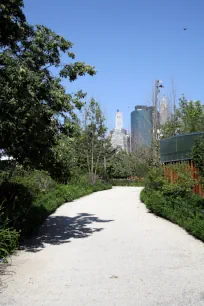
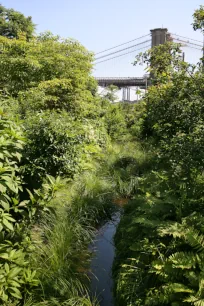
Background
For centuries, industrial facilities, warehouses and port activity posed a barrier between the residents of New York and its waterways. During the second half of the twentieth century, New York evolved from an industry oriented economy to a service oriented economy. As a result, numerous piers and warehouses along the waterfront stood abandoned, ready for redevelopment.
Since the 1990s, many of these waterfront areas have been converted into parks that reconnect the city with its waterways. Manhattan showed the way with some high profile projects such as the creation of Hudson River Park and East River Esplanade. Brooklyn followed in 2010 with the opening of its own high profile park, Brooklyn Bridge Park.
History
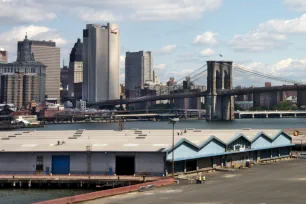
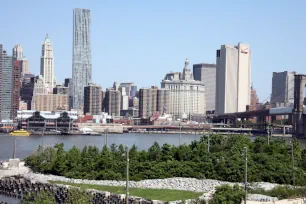
The 85 acre / 34 hectare large park is located on a site that was once the busiest spot along the Brooklyn waterfront. In 1642 the first ferry between Manhattan and Brooklyn departed from a wooden pier at the foot of Old Fulton Street. In the following decades, many more ferry services, handling both passenger and freight traffic, departed from here. Rail lines connected the ferry terminals with the hinterland, and warehouses were built to accommodate the growing freight traffic.
The opening of the Brooklyn Bridge in 1883 had a significant impact on the area. The bridge reduced the need for ferries, and they closed one by one. Nonetheless, the site of Brooklyn Bridge Park continued to be an active port area for decades. In the 1950s, many of the small old piers and warehouses were demolished and replaced by modern piers. Twenty years later the new piers had already been rendered obsolete due to the rise of container shipping, and in 1983 Piers 1-6 were abandoned.
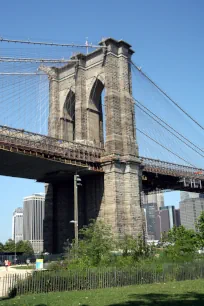
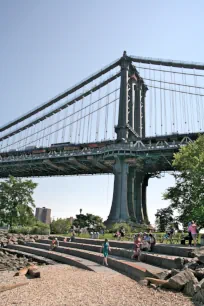
Creation of the Park
Developers saw a unique opportunity to build on the site along the East River – boasting unobstructed views of the Manhattan skyline – and proposals were created for the construction of high-rise buildings. A local non-profit organization opposed any development and instead, in 1985, launched the idea of a new waterfront park. After years of indecision, local authorities finally approved the creation of the Brooklyn Bridge Park in 2002.
Three years later, landscape designer Michael Van Valkenburgh unveiled a master plan for the conversion of the piers into parkland with recreational facilities. One of the priorities was to give people the opportunity to walk as close to the water’s edge as possible. The plan also incorporated the renovation of a couple of old warehouses to preserve and emphasize the historic industrial character of the neighborhood.
Construction of the park started in 2008 and the first section of the park, Pier 1, opened to the public in March 2010. The other piers opened in phases.
Park Layout
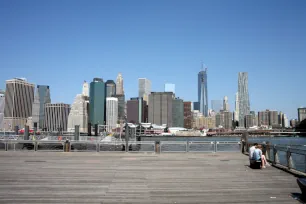
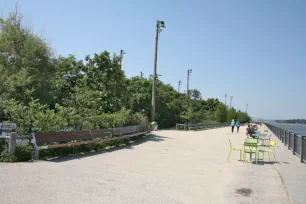
The heart of the park is Fulton Ferry Landing at the end of Fulton Street, the site where the first ferries departed. From the wooden pier, restored in 1993, you can enjoy magnificent views over downtown Manhattan.
On the west side, past the Brooklyn Bridge, are two pre-existing green spaces that are now incorporated into Brooklyn Bridge Park: Empire-Fulton Ferry Lawn, home to a vintage carousel, and Main Street Park, where a series of wide steps lead down to Pebble Beach: a small rocky beach with beautiful views of the Brooklyn Bridge.
To the east are Piers 1-6, which stretch all the way to Atlantic Avenue. Each pier has its own identity. Pier 1 includes sloping lawns with winding paths, a granite seating area with beautiful views of the harbor and a romantic pond. Along the waterside is a wide promenade with views over the East River towards Lower Manhattan and Government’s Island. The Squibb footbridge connects the pier with the promenade at Brooklyn Heights. Pier 2 is the only pier in the park that is mostly covered, by making use of the original warehouses that stood here. Inside are several courts for indoor sports. Pier 3 features green space centered around an artificial hill with an expansive lawn. Pier 4 consists of a small beach and a sunken wooden bridge that now function as a wildlife preserve. Pier 5 and 6 are home to several sports fields, a dog run and a playground as well as a marina.

